“Our culture comes from the forest. The forest teaches us how to live, and our culture teaches us how to protect the forest.
Nemonte Nenquimo, Waorani
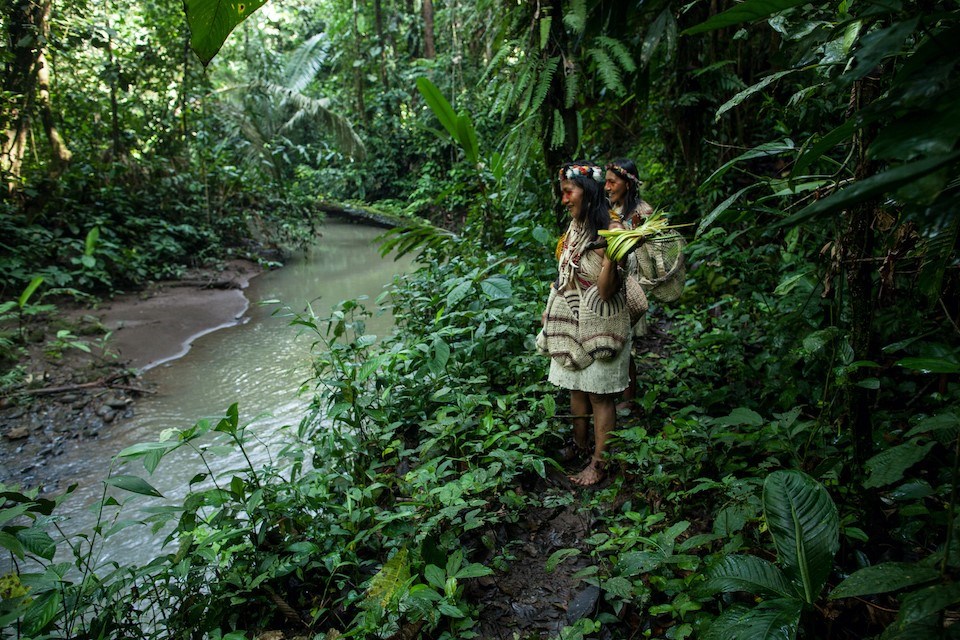 Waorani women in their ancestral territory, Ecuadorian Amazon.Amazon Frontlines, with permission
Waorani women in their ancestral territory, Ecuadorian Amazon.Amazon Frontlines, with permission
The short film,Who Should Decide the Future of the Amazon, produced by Amazon Frontlines, has been awarded the Environmental Hero Award in MY HERO’s 18th International Film Festival.
This powerful two-minute video documentary highlights the climate crisis in the western Amazon, created by the ongoing destruction of the traditional territories of Indigenous people who have safeguarded their lands for centuries. For the last half-century, the onslaught of crude oil drilling, monocropping, cattle farming, logging, mining, and other forms of unrelenting resource extraction have been depleting Indigenous peoples’ capacity to sustain their territories.
The film was created for the "Who Should Decide?" campaign by Amazon Frontlines in collaboration with the Waorani; Kofan; the Ceibo Alliance; and the regional (COICA), national (CONAIE), and Amazonian (CONFENIAE) Indigenous federations. The campaign aims to raise awareness of the urgent need to respect Indigenous people's right to decide over the future of their territories, cultures and lives, and to catalyze global action and support for frontline communities living in the Amazon Rainforest.
With brilliant scenes of natural beauty and the everyday life of the region's Indigenous peoples, the film asks, “Should the loggers decide the future of the Amazon? The oil executives? The miners?”
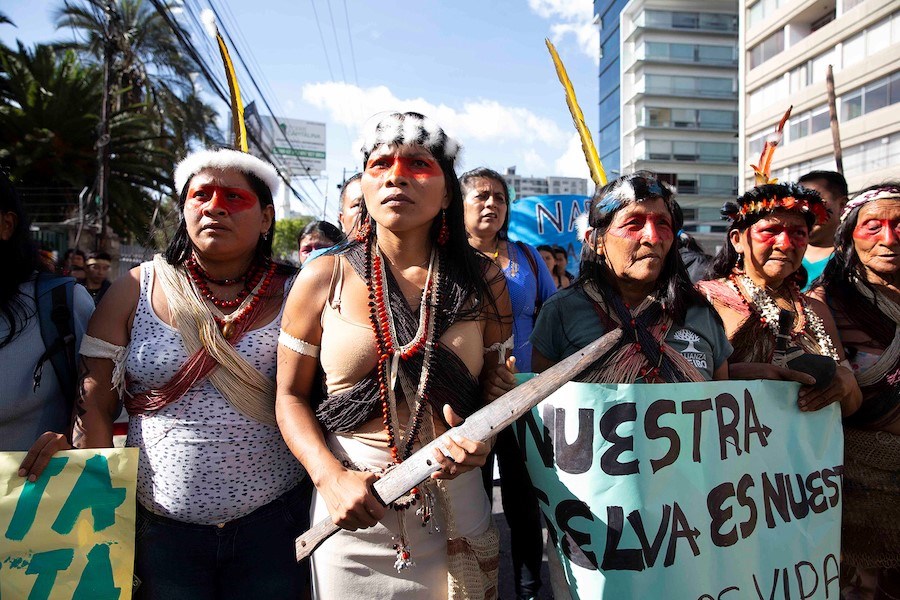 Waorani leader Nemonte Nenquimo alongside other Waorani women protest against oil drilling in their ancestral territory during a mobilization in the city of Quito, Ecuador.Amazon Frontlines, with permission
Waorani leader Nemonte Nenquimo alongside other Waorani women protest against oil drilling in their ancestral territory during a mobilization in the city of Quito, Ecuador.Amazon Frontlines, with permission
As Time Magazine Honoree Nemone Nenquimo said, “Indigenous peoples have defended our lands for thousands of years and our leadership must be respected and supported if we are to save our planet and future generations from destruction.” Most importantly, it is the Indigenous peoples who live in the Amazon Rainforest who should decide the future of the Amazon.
Amazon Frontlines and the Indigenous-led Ceibo Alliance, are working on concrete solutions with over 60 communities from the Siona, Secoya, Kofan and Waorani indigenous Nations in Ecuador, Peru and Colombia—four nations with over 20 villages in each nation. The global significance of the partnership lies in the fact that Indigenous people protect 80% of the world’s biodiversity, and lands managed by Indigenous peoples are ancient and effective forms of biodiversity conservation.
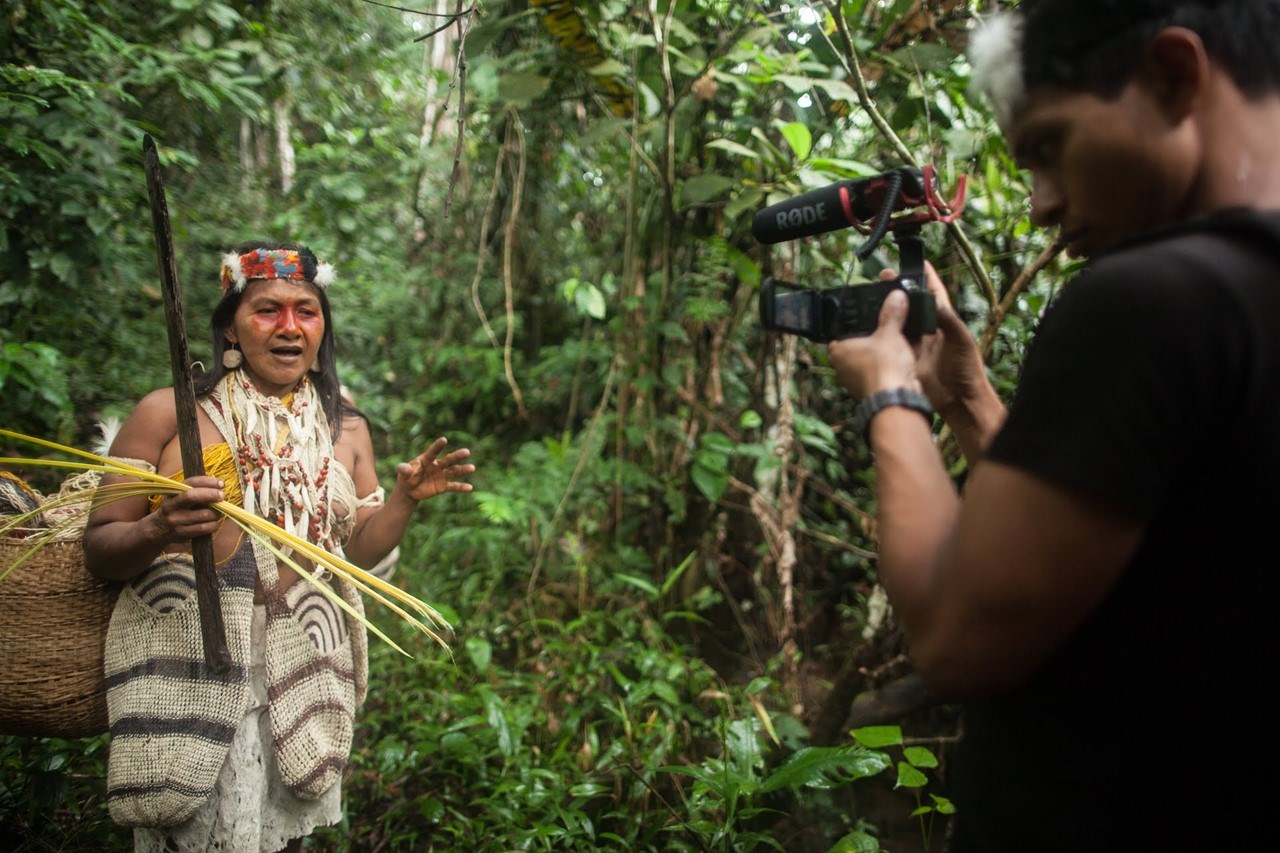 Waorani youth documenting his people's songs and stories, Ecuadorian AmazonAmazon Frontlines, with permission
Waorani youth documenting his people's songs and stories, Ecuadorian AmazonAmazon Frontlines, with permission
But thousands of years of cultural knowledge is now on the verge of disappearing. This includes Indigenous hunting, fishing, and agricultural techniques; plant medicines and healing systems; language, stories, and myths; as well as world views and pathways to spiritual enlightenment.
The path is clear: we can’t protect the climate or stop the extinction crisis if we don’t protect the rainforest and the cultures of its Indigenous stewards.
Telling Stories, Reviving Culture, and Defending Territory
The mission of Amazon Frontlines stems from the belief that: "Cultural pillars and keystone practices can only be identified by the Indigenous people themselves. From there, we work to promote cultural practices by practicing them, we recover traditional plants by planting them, and we work to reconnect youth with the forest and its spirits through ceremonies that have served that very function." Another major initiative involves training Indigenous youth to use film, photography, and other storytelling techniques to transmit the ancestors’ cultural knowledge and histories and to create extraordinary films that allow the world to witness Indigenous peoples' changing realities.
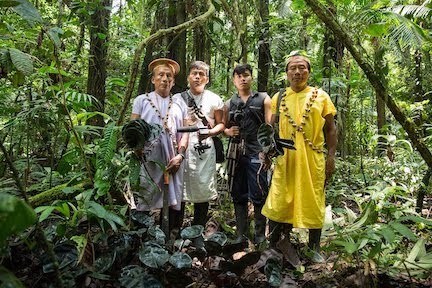 Siekopai youth and elders work together to create a documentary on the medicinal plant knowledge of their people. A documentary team (from left to right) Roberto Piaguaje, Jimmy Piaguaje, Ribaldo Payaguaje, and Gilberto Payaguaje pose for a portrait during a plant-collection expedition. Amazon Frontlines, with permission
Siekopai youth and elders work together to create a documentary on the medicinal plant knowledge of their people. A documentary team (from left to right) Roberto Piaguaje, Jimmy Piaguaje, Ribaldo Payaguaje, and Gilberto Payaguaje pose for a portrait during a plant-collection expedition. Amazon Frontlines, with permission
According to co-founder and director, Mitch Anderson, stories are a powerful aspect of Indigenous cultures: "Stories help us to understand our lives and what’s happening all around us, our idea of ourselves and what we must do. We are blessed to live and breathe Indigenous culture. People need to tell their stories to help see themselves in the 21st century, to see how stories transform the road ahead."
Elder Flor Tangoy, Siona Nation, sadly proclaimed: “Our elders are passing away, and with them thousands of years of knowledge is at risk of disappearing. Our stories have the power to keep our knowledge alive for future generations.”
“Now more than ever,” the organization states on its website, “Indigenous stories must be told, passed down to future generations and also shared with the outside world, whose destructive way of life is the root cause of cultural loss.”
We asked Anderson explain the problems Indigenous youth are facing:
There’s a lot of talk about reaching an ecological tipping point—the climate crisis due to clear-cutting roads leading to environmental degradation and hitting the tipping point in the Amazon. It is a severe situation, but there is less talk about culture.
Indigenous people are the owners of roughly half of the Amazon. This is some of the best-protected primary forest—there is a real threat to Indigenous stewardship: stewardship requires the cultural incentive to care for the forest for food, medicine, shelter, and meaning.
I have been living in the Amazon for 15 years. As we are surrounded by the dominant socioeconomic system, capitalism, cultural systems, roads, and so forth, youth are getting drawn into city, into the monetary economy. Some of our people are seeing the dominant society as the future, putting elders and the way of the forest in the past. Some are starting, like outsiders, to see the Amazon as a place to extract resources.
The 90% destruction along the road creates habitat loss, he said, so the land can’t support the community, leading to a situation where people have to depend on money and wage labor to survive. So youth living close to oil roads will have less connection to their culture. This reality requires “'redemptive globalizations'—connections and solidarity to support local initiatives to fight waves and waves of unrelenting resource extraction." And it requires listening to the people who have safeguarded the Amazon Rainforest for centuries.
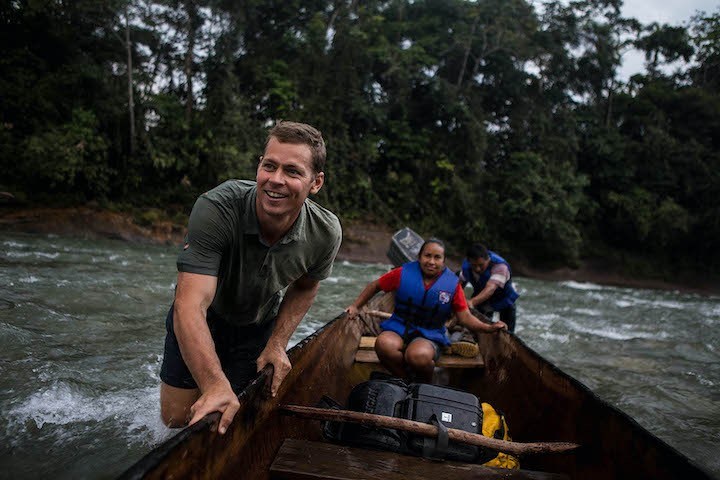 Mitch Anderson pushes a canoe along the Aguarico River in A’i Cofan ancestral territory, northern Ecuadorian Amazon. Amazon Frontlines, with permission
Mitch Anderson pushes a canoe along the Aguarico River in A’i Cofan ancestral territory, northern Ecuadorian Amazon. Amazon Frontlines, with permission
Our Interview with Mitch Anderson, Co-founder and Director of Amazon Frontlines
In an extended interview, we asked Anderson to talk about what led him to live and work in the Amazon.
Anderson was born and raised in suburban California, “where we take for granted where food, water, and gas comes from,” he told MY HERO. But coming from a supportive and loving family that encouraged free thinking and journeying, he said he felt free to pursue his passions.
He started working with Indigenous people in his twenties, when he had his “unsheltering” at Berkeley and became aware of their plight. He began traveling, and worked with the Mayans and Zapatistas in southern Mexico for three years. This, he said, is where he learned the importance of self-determination and self-government, and where he gained "a powerful and clear understanding of what was happening and why, and what Indigenous people really need."
Anderson’s first time to visit the Amazon was in 2011, when he started working with Amazon Watch. During the early months, a Kofan friend and leader, Emergildo Criollo, told him the story of his childhood—about seeing helicopters and the arrival of American oil companies. He had watched many trees being destroyed: it was the beginning of the oil boom, and there were toxic oil spills in their pristine rivers. Criollo lost his first two children to oil contamination.
“What was most enraging to me,” Anderson said, “were the American oil companies destroying the forests and Indigenous cultures, while the Indigenous people had been stewarding these forests for thousands of years.” At the time, he was involved in a Chevron lawsuit and the company was digging in its heels: “Chevron was spending millions to fight the Indigenous people--it was monstrous. It took four years to hold Chevron to account. We realized then that there would be no concrete results without clean water.”
A strong believer in self-determination and the power of listening, in 2011 Anderson asked the Indigenous nations of the region what they wanted to work on together: they responded, “education and clean water.” With Indigenous groups working together, the Clear Water Project was formed and built over 12,000 rainwater systems. The team also developed global partnerships with the schools: youth were speaking about reviving traditional knowledge and achieving self-determination, choice, and self-sufficiency. In those early days, Anderson said, he met many youth—the “dreamers of the people.” “Justice is not owned by capitalism or government. You can create justice and build prosperity from the ground up—and ensure clean water.”
 Waorani leader Nemonte Nenquimo alongside members of the Indigenous-led Ceibo Alliance. Amazon Frontlines, with permission
Waorani leader Nemonte Nenquimo alongside members of the Indigenous-led Ceibo Alliance. Amazon Frontlines, with permission
We asked Anderson to speak to us about his partnership with the Amazonian activist, Nemonte Nenquimo. He told us that when they met, Nenquimo was a young leader who deeply loved her culture and elders. Living with the Waorani and building water systems together, she became a dear friend and the two later married, becoming a formidable force in the fight to protect ancestral lands. Together they founded the Clear Water Project, Amazon Frontlines, and the Ceibo Alliance with a common vision to protect Indigenous lands and Indigenous peoples' ability to thrive on their territories. Amazon Frontlines was created to support Indigenous-led Ceibo Alliance in using cutting-edge technology, youth patrols to document illegal incursions, and to build a legal team to use the law to protect Indigenous territories from illegal logging, mining, and poaching and to protect Indigenous rights.
“I’m furious about what happened to the people, land, and rivers,” Anderson told MY HERO. “We realized we needed to build organizations and develop a comprehensive strategy that involved elders and youth, and ultimately save the Amazon and the climate for all of us.”
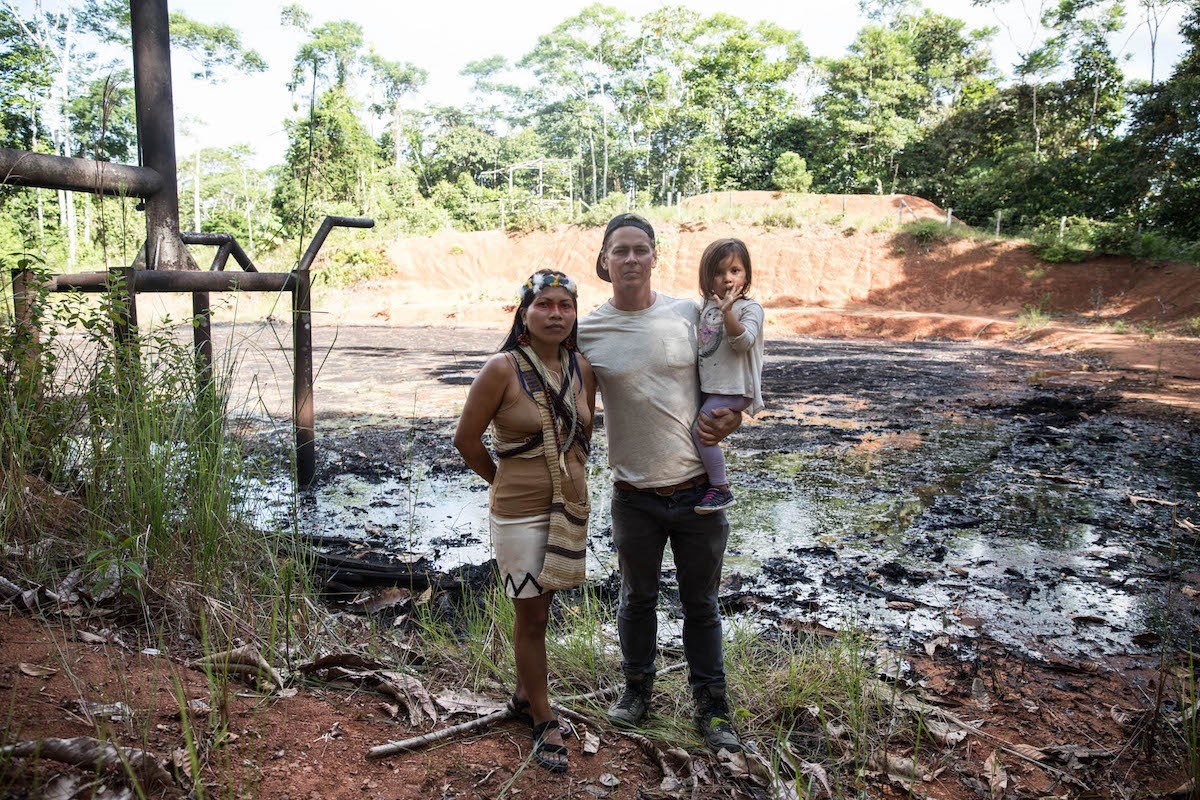 Waorani leader Nemonte Nenquimo and Amazon Frontlines Founder Mitch Anderson, with their daughter Daime, stand alongside a toxic waste pit of crude oil in the northern Ecuadorian Amazon near the city of Lago Agrio. Amazon Frontlines, with permission
Waorani leader Nemonte Nenquimo and Amazon Frontlines Founder Mitch Anderson, with their daughter Daime, stand alongside a toxic waste pit of crude oil in the northern Ecuadorian Amazon near the city of Lago Agrio. Amazon Frontlines, with permission
To accomplish this ambitious goal, we need to listen to, support, and ultimately build with Indigenous peoples of the Amazon—the people closest to the land, and support the youth to become future leaders who will make the important decisions for the future. As Anderson says, “We must have the courage to listen.”
While the Indigenous Amazonians should be on the forefront of deciding the future of the Amazon, they can't accomplish their goals without the help and support of the outside world.
Amazon Frontlines and Ceibo Alliance are building global allies for their legal battles over the destruction of their lands and rights. The alliance is composed of a diverse group of Indigenous activists, human rights lawyers, environmental activists, forestry specialists, environmental health scientists, filmmakers, journalists, anthropologists, and farmers, along with people from around the globe who want to contribute to saving the rainforest and the climate for our collective future.
To learn more about the Who Should Decide Campaign, please visit https://give.amazonfrontlines.org/campaign/who-should-decide-the-future-of-the-amazon/c373466
Film Credits
Directed by Martin Kingman
Executive Production by Amazon Frontlines
Field Production: Fabian Guiquita, Josefina Paushi, Nixon Andy, Nico Kingman
Music: Michael Angel Espinoza
Graphic Design: Lo Bueno Collectivo
Color grading: Jota Salazar
Follow Amazon Frontlines on Social Media:
https://www.amazonfrontlines.org
https://www.facebook.com/amazonfrontlines
https://twitter.com/AFrontlines
https://www.instagram.com/amazonfrontlines
https://www.linkedin.com/company/amazonfrontlines
See related films on the MY HERO website:
Rainforest Action With Nemonte Nenquimo: https://myhero.com/rainforest-action
Rights of Nature: https://myhero.com/rights-of-nature
Read about Amazon Frontlines' and Ceibo Alliance's big win in 2022:
https://myhero.com/behind-the-scenes-with-filmmakhttps://myhero.com/behind-the-scenes-with-filmmaker-will-parrinello-in-rights-of-nature-among-the-cofán
Page created on 11/16/2022 5:41:12 PM
Last edited 3/19/2023 8:29:23 PM
